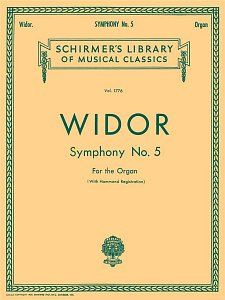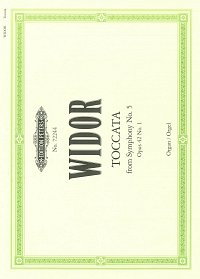Widor: Symphony No.5 / organ
| Publisher | SCHIRMER, Inc. |
| Genre: | classical & sacret |
| Arrangement: | organ |
| Cast: | solo |
| Difficulty: | Advanced |
| Format: | book |
| Series: | Schirmer's Library of Musical Classics |
Parameters
| Product code: | 50261640 |
| Composer: | Widor, Charles-Marie |
| No. of songs: | 5 |
| Pages: | 52 |
| Language: | English |
| Size: | 23 x 30 cm |
| UPC: | 073999616408 |
| ISBN: | 9798350124767 |
| Weight: | 188 g |
Songlist (5)
- Allegro vivace
- Allegro cantabile
- Andantino quasi allegretto
- Adagio
- Toccata (Allegro)
Product description
Organ Symphony No. 5 is one of the most important works of Charles-Marie Widor. Completed in 1879, it is part of a cycle of ten organ symphonies in which Widor developed a symphonic style for solo organ. The Fifth Symphony consists of five movements and culminates in the final Toccata, which has become one of the most performed organ works. Its vigorous ostinato in the right hand and monumental conclusion have made it a favourite piece for festive occasions. The entire symphony is an example of Widor's mastery of sound colour, dynamics and contrasts, which give the work its orchestral character.
Charles-Marie Widor (1844-1937) was a French composer, organist and teacher, best known for his organ symphonies. Widor is considered one of the most important organ composers of the 19th century. He served as organist at the Saint-Sulpice Church in Paris, where he played the famous Aristide Cavaillé-Coll organ for more than 60 years. His works include ten organ symphonies, the most famous of which is the Fifth Symphony with its iconic final movement, the "Toccata". This piece has become an iconic piece of organ repertoire and is often played on celebration occasions around the world. Widor was also an important teacher, with Marcel Dupré and Olivier Messiaen among his students. In addition to organ music, he also composed orchestral and vocal works. His innovative approach laid the foundations of the modern French organ school and influenced generations of musicians.









